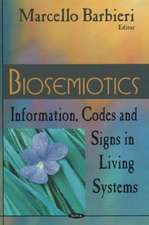Bioinformatics for Systems Biology
Editat de Stephen Krawetzen Limba Engleză Paperback – 23 aug 2016
| Toate formatele și edițiile | Preț | Express |
|---|---|---|
| Paperback (1) | 1012.56 lei 6-8 săpt. | |
| Humana Press Inc. – 23 aug 2016 | 1012.56 lei 6-8 săpt. | |
| Hardback (1) | 1032.84 lei 6-8 săpt. | |
| Humana Press Inc. – 17 feb 2009 | 1032.84 lei 6-8 săpt. |
Preț: 1012.56 lei
Preț vechi: 1265.69 lei
-20% Nou
Puncte Express: 1519
Preț estimativ în valută:
193.78€ • 210.41$ • 162.77£
193.78€ • 210.41$ • 162.77£
Carte tipărită la comandă
Livrare economică 23 aprilie-07 mai
Preluare comenzi: 021 569.72.76
Specificații
ISBN-13: 9781493956807
ISBN-10: 1493956809
Pagini: 639
Ilustrații: XIII, 639 p.
Dimensiuni: 178 x 254 mm
Greutate: 1.12 kg
Ediția:Softcover reprint of the original 2nd ed. 2009
Editura: Humana Press Inc.
Colecția Humana
Locul publicării:Totowa, NJ, United States
ISBN-10: 1493956809
Pagini: 639
Ilustrații: XIII, 639 p.
Dimensiuni: 178 x 254 mm
Greutate: 1.12 kg
Ediția:Softcover reprint of the original 2nd ed. 2009
Editura: Humana Press Inc.
Colecția Humana
Locul publicării:Totowa, NJ, United States
Cuprins
Life of a Cell and Its Analysis.- Structure and Function of the Nucleus and Cell Organelles.- Transcription and the Control of Gene Expression.- RNA Processing and Translation.- DNA Replication, Recombination, and Repair.- Cell Signaling.- Epigenetics of Spermiogenesis.- Genomic Tools for Analyzing Transcriptional Regulatory Networks.- Statistical Tools and Their Application.- Probability and Hypothesis Testing.- Stochastic Models for Biological Patterns.- Population Genetics.- Statistical Tools for Gene Expression Analysis and Systems Biology and Related Web Resources.- Transcriptome Analysis.- What Goes in is What Comes Out: How to Design and Implement a Successful Microarray Experiment.- Tools and Approaches for an End-to-End Expression Array Analysis.- Analysis of Alternative Splicing with Microarrays.- Structural and Functional Sequence Analysis.- An Introduction to Multiple Sequence Alignment — and the T-Coffee Shop. Beyond Just Aligning Sequences: How Good can you Make your Alignment, and so What?.- A Spectrum of Phylogenetic-Based Approaches for Predicting Protein Functional Sites.- The Role of Transcription Factor Binding Sites in Promoters and Their In Silico Detection.- In Silico Discovery of DNA Regulatory Sites and Modules.- Literature Mining for Association and Meaning.- Mining the Research Literature in Systems Biology.- GoPubMed: Exploring PubMed with Ontological Background Knowledge.- BiblioSphere — Hypothesis Generation in Regulatory Network Analysis.- Biological Knowledge Extraction.- Genomic Databases.- Using KEGG in the Transition from Genomics to Chemical Genomics.- Ensembl.- Management of Spatially Organized Biological Data using EMAGE.- Equality of the Sexes? Parent-of-Origin Effects on Transcription and de novo Mutations.- BiologicalNetworks.- Methods for Structural Inference and Functional Module Identification in Intracellular Networks.- Methods for Dynamical Inference in Intracellular Networks.- ASIAN: Network Inference Web Server.- Bridging the Gap.- Bioinformatics for Metabolomics.- Virtual Reality Meets Functional Genomics.- Systems Biology of Personalized Medicine.
Textul de pe ultima copertă
The biological sciences are now in the midst of a true life sciences revolution akin to what physics experienced just after the turn of the last century. We are now in a phase of unparalleled growth that is reflected by the amount of data generated from each experiment. At the time of this writing, the rate of data acquisition was approaching 2 terabytes over the course of 5 days with first pass analysis proceeding over the following 2-3 week period. This fundamental shift has provided unprecedented opportunities that for the first time afford us the ability, i.e., means, breadth, and depth of data, to truly address human biology at the systems level. This wealth of information from seemingly disparate datasets and its integration is being realized through bioinformatics. It is with this philosophy that the text Bioinformatics for Systems Biology was born. This revolution has spawned true personalized medicine that encompasses diagnostics and treatment through to cure.
For the physical and computer scientist, this text provides an introduction to the basic biological principles governing a cell. This quickly moves from the fundamentals to exploring the underlying genetic processes. While providing a rudimentary and necessary overview for the life scientist, the physical and computer scientist will be apprised of various nuances within the field reflecting the reality of "wet-bench" science. For those in the life sciences, it I rapidly becoming appreciated that we now progressing from examining our favorite "pet" gene to the system. Statistics is now an essential component to understand the vast datasets and this is emphasized throughout the text.
The majority of the text is devoted to the common ground that these groups share. It provides rich examples of tools, databases, and strategies to mine the databases to reveal novel insights. A host of examples of parsing the data into a series of overlays that use various presentation systems are reviewed. The goal is to provide a representation most comfortable to the user to enable the user to thoroughly explore the data. The text concludes with examples of how the systems information is used to inform personalized medicine in a true "bench to bedside" manner.
Bioinformatics for Systems Biology bridges and unifies many disciplines. It presents the life scientist, computational biologist, and mathematician with a common framework. Only by linking the groups together may the true life sciences revolution move forward in the mostly uncharted and emerging field of Systems Biology.
For the physical and computer scientist, this text provides an introduction to the basic biological principles governing a cell. This quickly moves from the fundamentals to exploring the underlying genetic processes. While providing a rudimentary and necessary overview for the life scientist, the physical and computer scientist will be apprised of various nuances within the field reflecting the reality of "wet-bench" science. For those in the life sciences, it I rapidly becoming appreciated that we now progressing from examining our favorite "pet" gene to the system. Statistics is now an essential component to understand the vast datasets and this is emphasized throughout the text.
The majority of the text is devoted to the common ground that these groups share. It provides rich examples of tools, databases, and strategies to mine the databases to reveal novel insights. A host of examples of parsing the data into a series of overlays that use various presentation systems are reviewed. The goal is to provide a representation most comfortable to the user to enable the user to thoroughly explore the data. The text concludes with examples of how the systems information is used to inform personalized medicine in a true "bench to bedside" manner.
Bioinformatics for Systems Biology bridges and unifies many disciplines. It presents the life scientist, computational biologist, and mathematician with a common framework. Only by linking the groups together may the true life sciences revolution move forward in the mostly uncharted and emerging field of Systems Biology.





